Are you ready to improve your cycling workouts? With an inground trampoline, you can practise your aerial skills! With the help of this effective training equipment, you can practise safety and convenience while turning your garden into a fun playground. With an in-ground trampoline, you can develop balance, control and even confidence while having a lot of fun as you work on everything from the fundamentals to more difficult routines. Now it’s time to take your riding to the next level and explore endless training options!
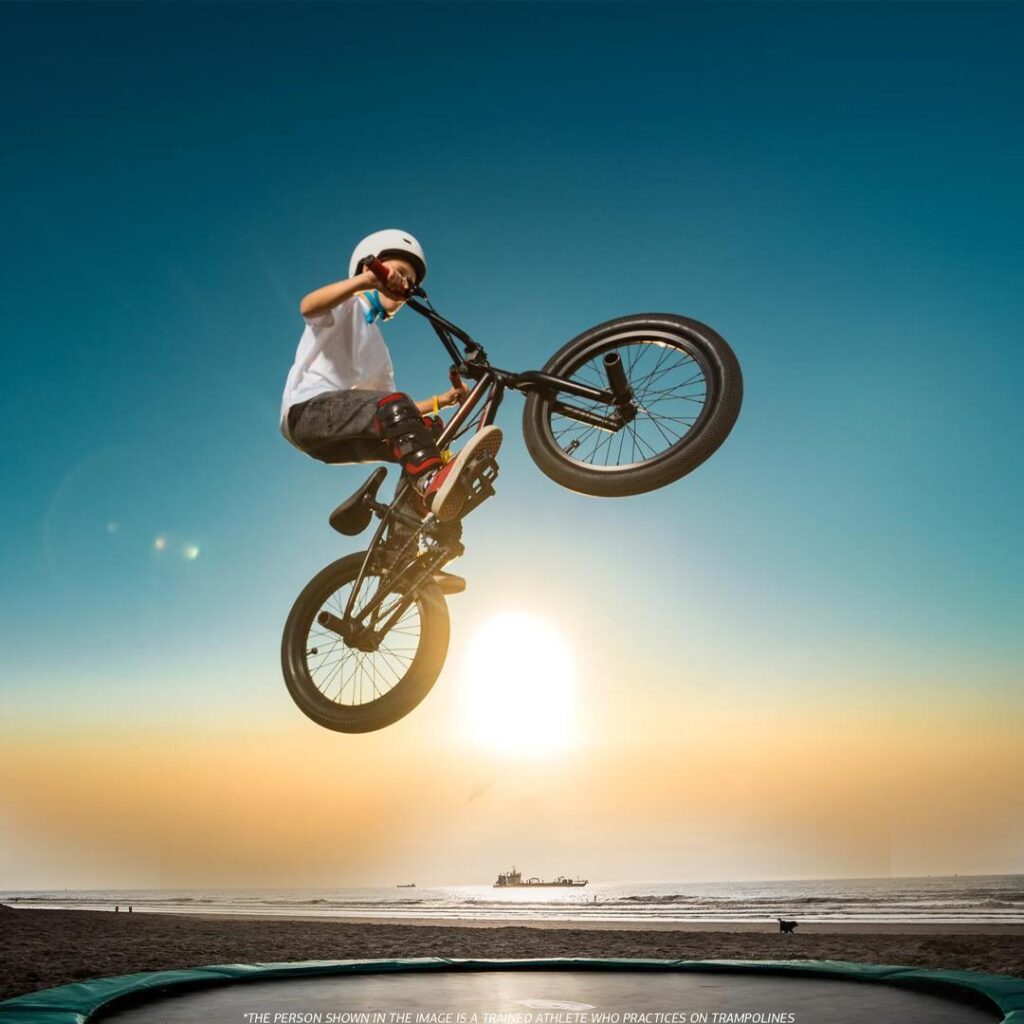
This blog explores effective techniques for using an in-ground trampoline to boost your mountain bike trick training at home. Whether you aim to enhance skills, learn new tricks, or enjoy a unique training experience, this guide is your go-to resource. Transform your garden into a mountain biking playground!
Benefits of Using an In-Ground Trampoline for Bike Training
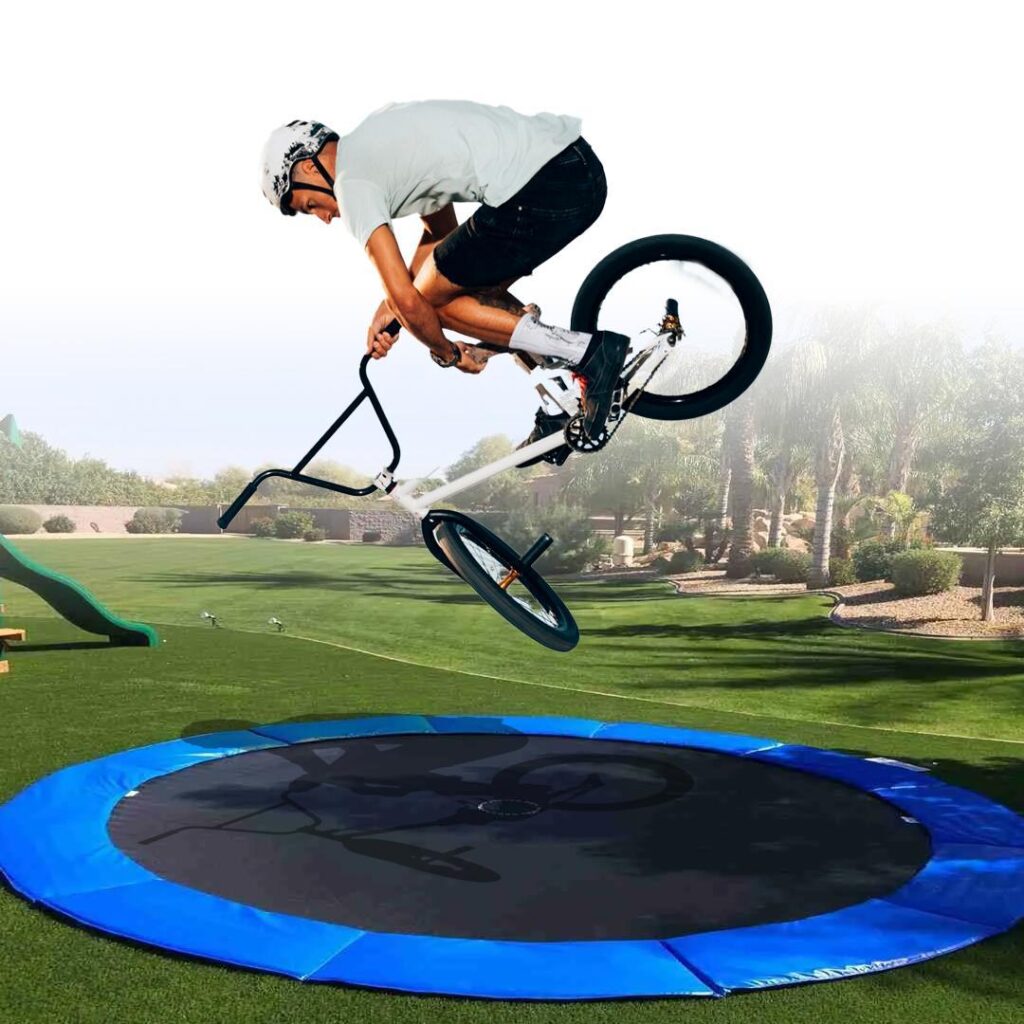
Using an in-ground trampoline for bike training offers a host of benefits that can significantly elevate your skill level and training experience:
Safety
Riding a mountain bike requires you to push limits and try difficult movements. Compared to hard ground or uneven terrain, an in-ground trampoline’s soft, springy surface absorbs impact and lowers the chance of damage. Because of this safety element, you can practise with more confidence, which motivates them to try new things and develop without worrying about taking major tumbles.
Enhanced Skill Development
Family Trampoline offers a safe space where users may concentrate on improving their control and balance. The trampoline’s steady bounce simulates the air time riders feel during jumps and tricks, which aids in the improvement of their timing and spatial awareness. This directly correlates to riders having better bike handling skills on trails as they learn how to manoeuvre around obstacles and stay stable in tough terrain.
Convenience
The convenience that comes with owning an in-ground trampoline is among its biggest benefits. Sport Trampoline training is a great way to exercise in your backyard, as opposed to traditional mountain riding, which frequently requires access to particular routes or terrain. Because of its accessibility, you can practise whenever it’s convenient for you, be it in the morning, late at night, or even in inclement weather that would ordinarily discourage riding outside.
For enjoying the benefits of using an in-ground trampoline for bike training, it’s crucial to properly prepare your bike for optimal performance and safety during trampoline sessions. Let’s learn about the preparation of bikes for trampoline use.
Preparing Your Bike for Trampoline Training
Before you start practising your mountain bike tricks on an in-ground trampoline, it’s essential to ensure your bike is equipped and maintained properly. Here’s what you need to know:
Bike Modifications for Trampoline Use
While your bike may already be in good shape for outdoor riding, trampoline training introduces different dynamics that may require some adjustments:
- Remove Attachments: Remove any additional objects that might restrict your movement or endanger your safety, like racks or water bottle holders.
- Lower Tyre Pressure: Tyres pressure can be significantly lowered to increase stability and traction on the trampoline surface when doing jumps and tricks.
- Secure Loose Parts: Make sure that every screw and fastener is tightened all the way to avoid any parts coming free or falling off when bouncing around a lot.
Recommended Bike Types
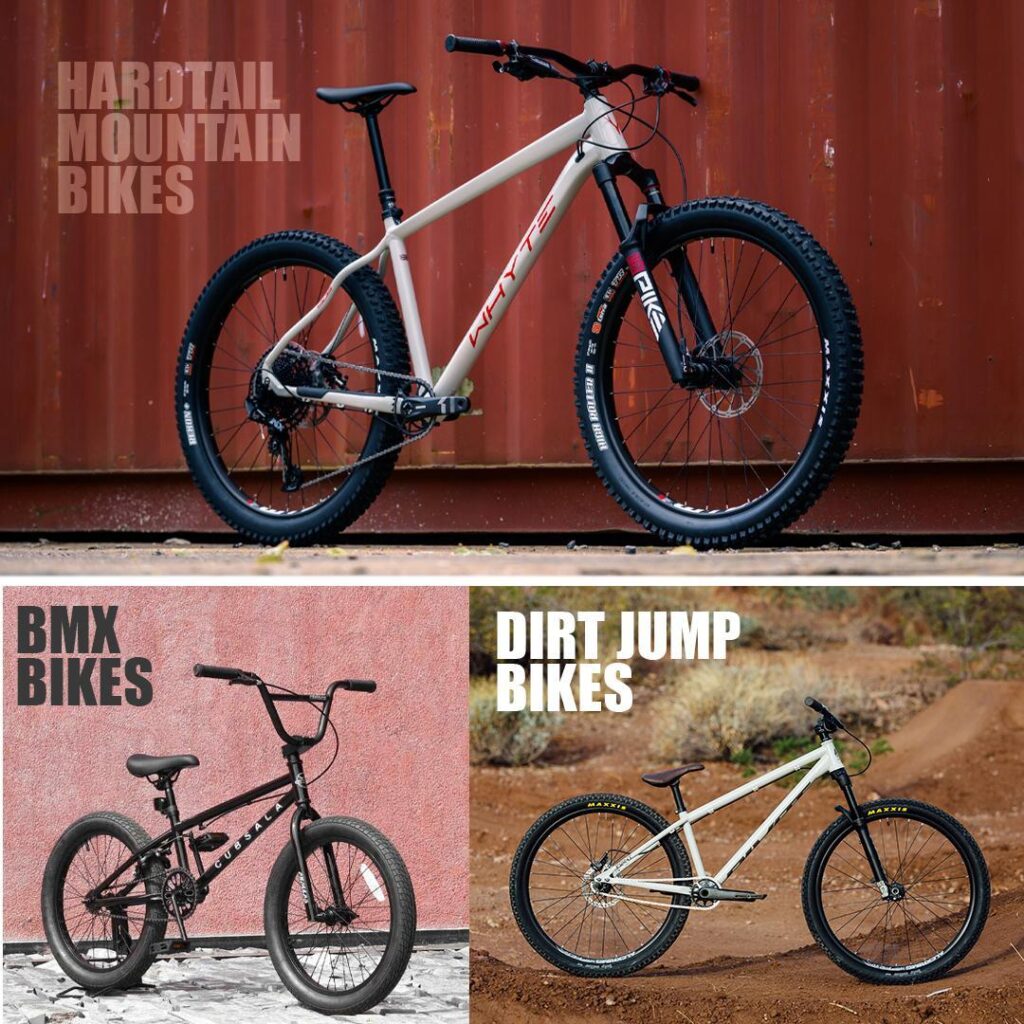
Not all bikes are equally suited for trampoline training. Here are some recommendations:
- Hardtail Mountain Bikes: These bikes are ideal due to their durable frames and suspension systems, which can handle the impact of jumps and landings on a trampoline.
- BMX Bikes: BMX bikes are designed for tricks and jumps, making them suitable for trampoline use. Their compact size and sturdy build make them easy to manoeuvre in tight spaces.
- Dirt Jump Bikes: Specifically built for jumping and tricks, dirt jump bikes are another excellent choice. They are lightweight yet robust enough to withstand the stresses of trampoline training.
Safety Checks and Maintenance
Safety should always be a priority, even on a trampoline. Perform these checks regularly:
- Inspect Brakes: Ensure your brakes are in good working condition and responsive. Adjust brake pads if necessary to maintain optimal braking power.
- Check Frame Integrity: Examine your bike frame for any signs of cracks or damage. A compromised frame can lead to serious accidents during training.
- Verify Handlebar and Stem Tightness: Ensure your handlebars and stem are firmly secured to the fork. Loose handlebars can cause loss of control and potentially dangerous situations.
Once your bike is prepped for trampoline training, mastering these basic tricks sets the stage for advancing your mountain biking skills with confidence and control.
Trick and techniques on In-ground Trampoline
Before diving into mastering basic tricks on an in-ground trampoline, ensure your bike is ready for optimal performance and safety:
Basic Tricks to Start With
When starting your journey into public use trampoline training for mountain bike tricks, mastering these fundamental manoeuvres can build your skills and confidence:
- Wheelies: Practise lifting your front wheel off the ground while maintaining balance and control.
- Bunny Hops: Learn to lift both wheels off the ground simultaneously, essential for clearing obstacles and enhancing manoeuvrability.
- Endos (Stoppies): Learn how to raise your back wheel off the ground and balance using your front wheel for precise turns and calm descents.
- Manuals: Practise riding on your rear wheel while keeping your front wheel elevated, crucial for maintaining momentum and control over rough terrain.
After mastering the basic tricks, advance to intermediate tricks and techniques on the trampoline to raise your mountain biking prowess to new heights of skill and finesse.
Intermediate Tricks and Techniques
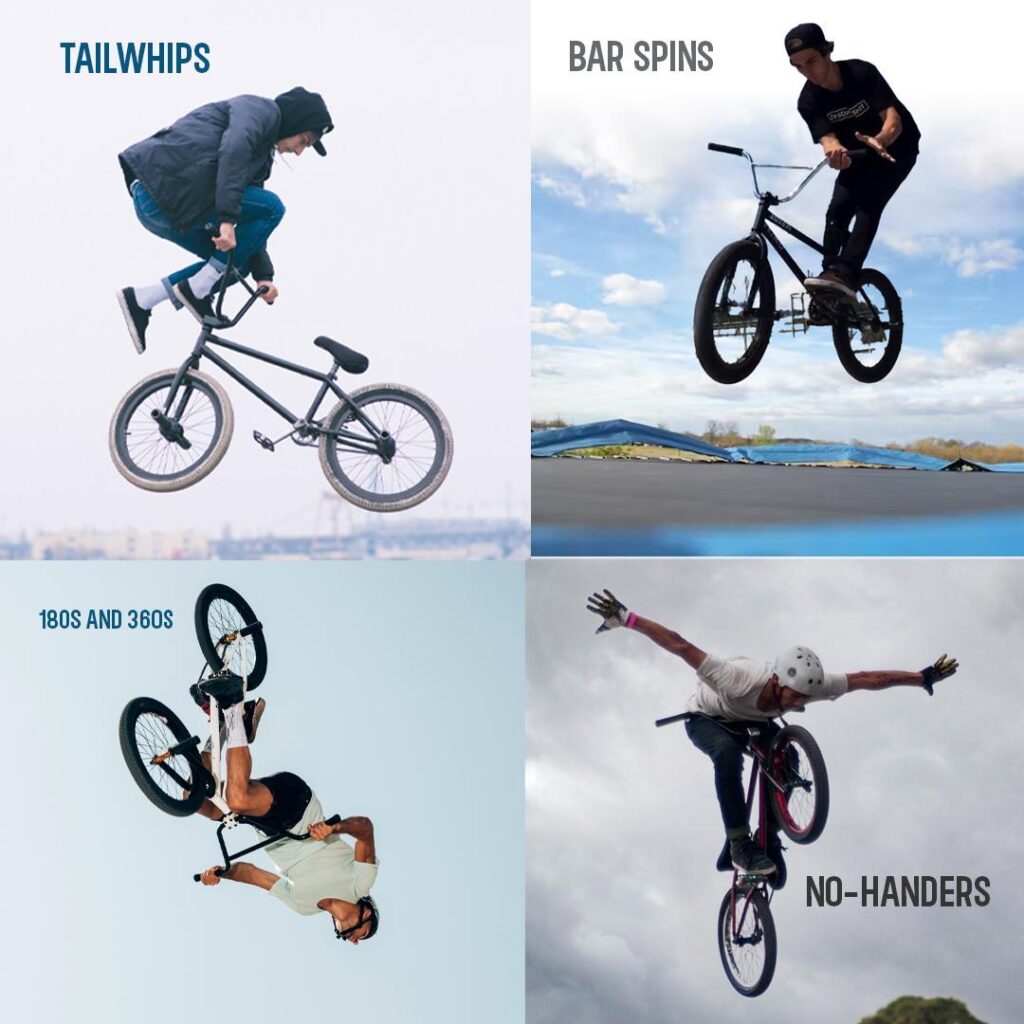
Once you’ve mastered the basic manoeuvres on the trampoline, it’s time to challenge yourself with these intermediate-level tricks and techniques:
- Tailwhips: Execute a 360-degree rotation of the bike frame around the handlebars while in mid-air, landing smoothly back on the trampoline surface.
- Bar Spins: Rotate the handlebars 180 or 360 degrees while airborne, requiring precise timing and coordination to maintain balance throughout the manoeuvre.
- 180s and 360s: Perform half (180 degrees) or full (360 degrees) rotations of your entire body and bike in mid-air, enhancing spatial awareness and agility.
- No-handers: Release your hands from the handlebars while maintaining control and balance, showcasing confidence and control in aerial manoeuvres.
Perfecting intermediate tricks on the trampoline sets the stage for advancing into daring and technically demanding manoeuvres, propelling your mountain biking skills to thrilling new heights.
Advanced Tricks for the Bold
Once you’ve mastered intermediate tricks on the trampoline, challenge yourself with these exhilarating and technically demanding manoeuvres:
- Backflips: Rotate your bike and body backwards in a full 360-degree flip, landing smoothly back on the trampoline surface.
- Front Flips: Execute a forward rotation of your bike and body, completing a full flip in mid-air before landing with precision.
- Superman Seat Grabs: Extend your body horizontally from the bike, holding onto the seat while airborne, showcasing agility and control.
- Flair Tricks: Combine a backflip with a 180-degree spin, adding a stylish twist to your aerial repertoire.
After mastering advanced tricks, implementing effective training tips and techniques will help you refine your skills and achieve even greater heights in your mountain biking journey.
Training Tips and Techniques
To maximise your mountain bike trick training on an inground trampoline is worth it, to incorporate these effective tips and techniques:
Gradual Progression
Begin your training journey by mastering fundamental tricks such as wheelies, bunny hops, and manuals. Focus on perfecting each technique before advancing to more complex manoeuvres like tailwhips and bar spins. Gradual progression not only builds a solid foundation of skills but also boosts confidence as you conquer each new challenge step by step.
Consistency and Practice Routines
Consistency is key to improvement. Make a practice schedule that works for your responsibilities and lifestyle. Dedicate focused sessions to specific tricks and techniques, allowing ample time for repetition and refinement. Whether it’s daily drills or structured weekly sessions, consistency will accelerate your learning curve and enhance muscle memory crucial for executing tricks with precision.
Mental Preparation and Visualization Techniques
Before every training session, mentally get ready by visualising yourself pulling off tricks. Reinforcing brain networks through visual imagery enhances coordination and reaction times. To mentally get ready to overcome challenges during real practice, mentally practise the movement sequence and foresee difficulties. Use deep breathing exercises and other relaxation methods to help you stay composed and focused, which will improve your performance on the trampoline overall.
Equipped with effective training tips and techniques, it’s crucial to also prioritise safety and injury prevention to ensure a safe and successful mountain biking experience.
Safety Tips and Injury Prevention
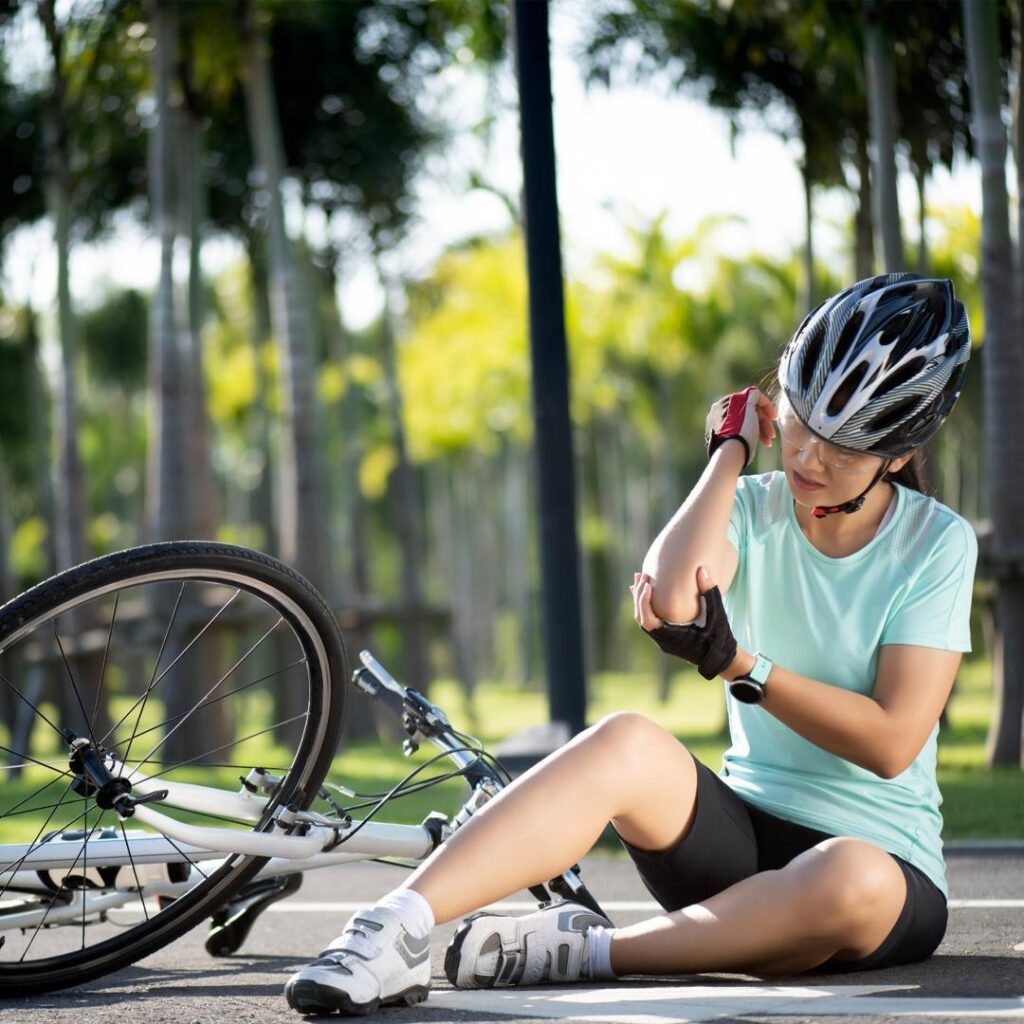
Ensuring your safety while practising mountain bike tricks on a trampoline is paramount. Here are some essential tips to keep you protected and prepared:
Importance of Wearing Protective Gear
Always wear the appropriate protective gear to minimise the risk of injury:
- Helmet: A well-fitted helmet protects your head from impacts and is non-negotiable.
- Knee and Elbow Pads: These pads shield your joints from scrapes and bruises, reducing the impact of falls.
- Gloves: Wearing gloves improves grip and protects your hands from abrasions.
- Shin Guards: These protect your shins from pedal strikes and other impacts.
Wearing the right gear not only enhances safety but also boosts your confidence, allowing you to focus on perfecting your tricks.
Spotting Techniques and Having a Training Partner
Training with a partner can significantly improve safety and provide support:
- Spotting Techniques: A training partner can act as a spotter, helping to guide you through new tricks and providing immediate assistance if you lose balance.
- Encouragement and Feedback: A partner can offer valuable feedback on your technique and encourage you to push your limits safely.
- Shared Learning: Training with someone else fosters a collaborative environment where you can learn from each other’s successes and mistakes.
How to Handle Falls and Minor Injuries
Despite precautions, falls and minor injuries can happen. It’s important to know how to deal with them:
- Stay Calm: If you fall, try to remain calm and assess your condition. Take a few moments to catch your breath and check for any injuries.
- Roll with the Fall: If possible, try to roll when you fall to distribute the impact over a larger area of your body, reducing the severity of the injury.
- First Aid Basics: Keep a basic first aid kit nearby to treat minor cuts and bruises. Cleaning and bandaging small wounds promptly can prevent infections.
- Rest and Recover: If you sustain a more serious injury, rest and give your body time to heal. Ignoring discomfort can make injuries worse and take longer to heal.
By prioritising safety and knowing how to prevent and handle injuries, you create a safer and more enjoyable training environment. This approach ensures you can continue to progress and enjoy the thrill of mountain bike trick training on your in-ground trampoline with peace of mind.
Conclusion
Training on an in-ground trampoline opens up a world of fun and skill development for mountain bikers of all levels. The unique blend of safety, convenience, and the ability to practise tricks right in your garden makes it an exciting addition to your routine. Whether you’re just starting with basic manoeuvres or pushing the limits with advanced tricks, the trampoline offers a dynamic and engaging training platform.
So, gear up, prep your bike, and start bouncing your way to mastering those impressive tricks. Embrace the thrill, enjoy the process, and remember to stay safe. We’d like to hear about your experiences and progress—share your journey and any tips you’ve discovered in the comments section below. Happy riding and happy bouncing!
Yes, you can perform various tricks with a mountain bike, including wheelies, bunny hops, and jumps, utilising its robust build and versatile design.
For beginners, start with basic cycle stunts like wheelies, bunny hops, and endos by practising balance, timing, and control in a safe, open area.
To bunny hop a MTB, compress your body downwards, then pull up on the handlebars to lift the front wheel followed by the rear wheel, using a springing motion to clear obstacles.
Yes, it’s OK to do wheelies on a mountain bike, as long as you practise in a safe area and ensure proper technique to avoid injury and bike damage.
You can practise cycling at home using a stationary bike or a bike trainer, incorporating virtual cycling apps for guided workouts and simulating outdoor riding conditions.





